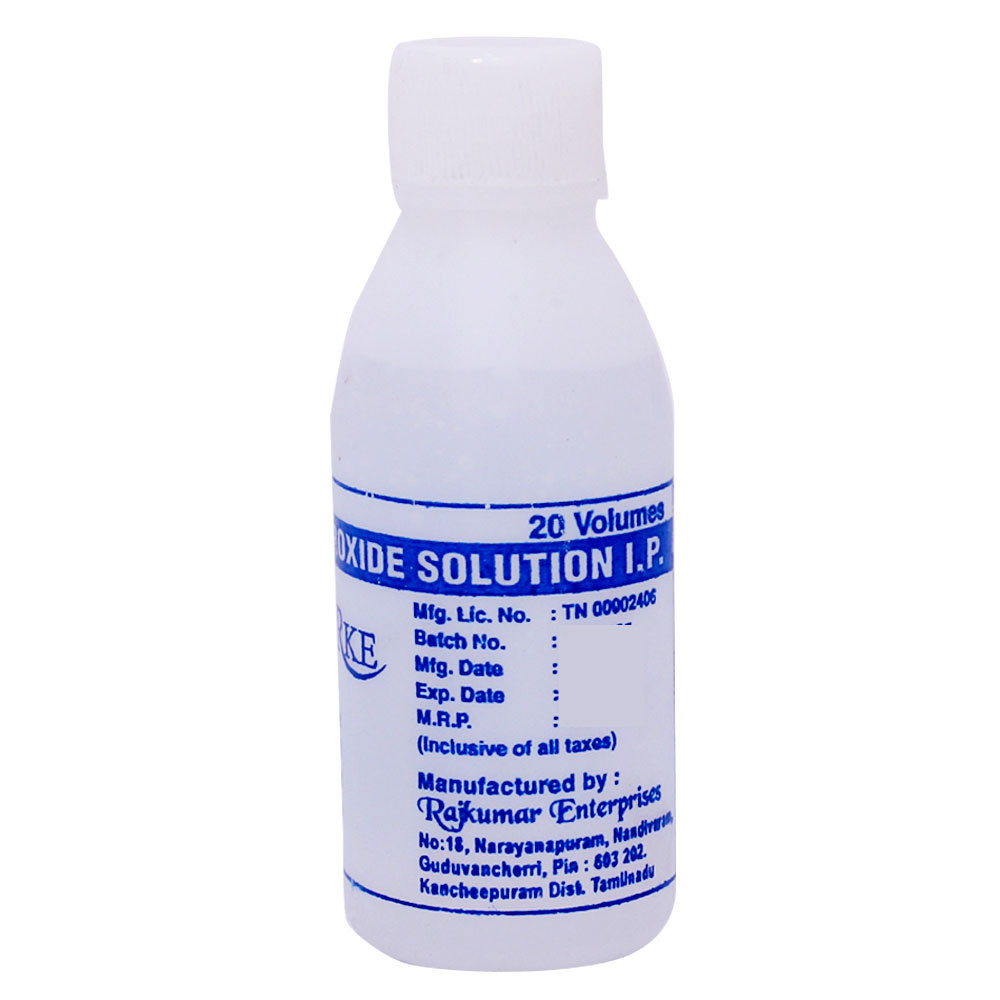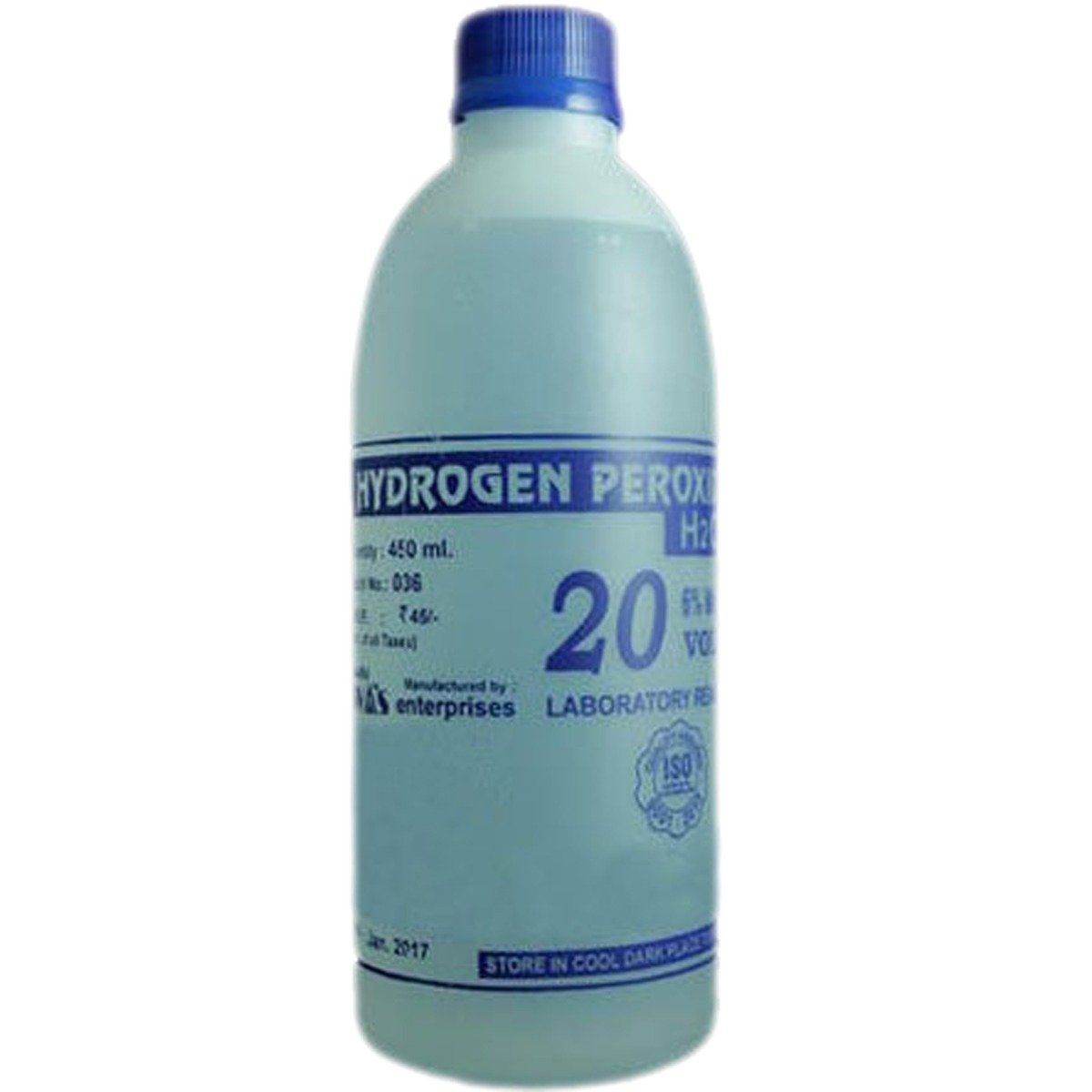Hydrogen Peroxide
About Hydrogen Peroxide
Hydrogen Peroxide belongs to the group of topical antiseptics with antibacterial, antifungal, and antiviral properties. It is used to prevent infections occurring due to open scrapes, cuts, and wounds. Hydrogen Peroxide is also used in the treatment of leg ulcers and pressure sores. Venous ulcers (leg ulcers) are caused due to pooling of blood in the leg veins. Pressure sores are sores caused by lying or sitting in the same position for a long period.
Hydrogen Peroxide contains ‘’Hydrogen Peroxide’’ that works by liberating oxygen when applied to the affected area. The released oxygen froths and foams, help in cleaning the area of application. Hydrogen Peroxide also functions by producing destructive free radicals of oxygen that attack the pathogen’s cell membrane and DNA, and thus destroy the pathogen and arrest the progression of the disease.
Hydrogen Peroxide should be used as advised by your doctor. It is an external preparation. Hence, avoid contact with eyes, nose, and mouth. In case of accidental use, wash it thoroughly and inform your doctor. Wash your hands before applying the Hydrogen Peroxide. In some cases, Hydrogen Peroxide may cause certain side effects such as temporary stinging or redness. Most of these side effects do not require medical attention and will resolve gradually over time. However, you are advised to talk to your physician if you experience these side effects consistently.
Hydrogen Peroxide should be avoided if you are allergic to it or any of its components. Let your doctor know about your entire medical history including any other topical medications or oral medicines, herbs, or vitamins you may be using. Avoid using Hydrogen Peroxide for more than 3 weeks at a stretch. Do not use Hydrogen Peroxide on large, deep wounds or healthy, intact skin. Hydrogen Peroxide is not meant to be used as an enema or as a laundry detergent. Note that Hydrogen Peroxide may bleach fabrics. Consult your physician before using Hydrogen Peroxide during pregnancy or if you are breastfeeding.
Uses of Hydrogen Peroxide
Medicinal Benefits
Hydrogen Peroxide is a topical agent that has antiseptic, antibacterial, antifungal, and antiviral properties. It contains Hydrogen Peroxide. Hydrogen Peroxide is used to cleanse the area it’s applied to and to prevent any further infection of the open cut, scrape, or wound. Hydrogen Peroxide functions as an antiseptic by virtue of its bacteria and fungus-killing nature. Hydrogen peroxide acts against various bacteria, viruses, fungi, yeast, and spores. Hydrogen Peroxide works by liberating oxygen when applied to the affected area. The released oxygen froths and foams help in cleaning the area of application. Hydrogen Peroxide also shows emulsifying qualities that help its surface action, thereby relieving itching, redness, inflammation, and irritation of the skin. Hydrogen Peroxide is hence used to treat surface-level itches, leg sores, pressure sores, skin breaks, and superficial infections.
Directions for Use
Storage
Side Effects of Hydrogen Peroxide
- Transient redness
- Stinging
- Irritation and itching at the site of application
- Appearance of a thin film post-application
Drug Warnings
Inform the physician if you are allergic to Hydrogen Peroxide or any of its components. Discuss your medical history with the doctor, along with any other topical medications, oral medicines, herbs or vitamins you may be using. Avoid using Hydrogen Peroxide for more than three weeks at a stretch. Do not use Hydrogen Peroxide on large, deep wounds or healthy, intact skin. Hydrogen Peroxide is not meant to be used as an enema or as a laundry detergent. Note that Hydrogen Peroxide may bleach fabrics. Consult your physician before using Hydrogen Peroxide during pregnancy or if you are breastfeeding. Avoid wearing tight, and dark-coloured clothing on the affected area after applying Hydrogen Peroxide as Hydrogen Peroxide may bleach fabrics. Avoid getting Hydrogen Peroxide in your eyes and nostrils.
Drug Interactions
Drug-Drug Interactions: Hydrogen Peroxide may interact with other oxidizing agents (iodine, permanganate) and protein (oxymyoglobin).
Drug-Food Interactions: No interaction found.
Drug-Disease Interactions: No interactions found.
Drug-Drug Interactions Checker List:
Safety Advice

Alcohol
cautionNo interaction was found/established. However, it is advisable to avoid or limit consumption of alcohol as a precautionary measure.

Pregnancy
consult your doctorHydrogen Peroxide is mostly safe to use during pregnancy. However, Hydrogen Peroxide should be used only when a healthcare professional assesses the benefits and risks.

Breast Feeding
cautionHydrogen Peroxide is probably safe to use during breastfeeding. However, consult your doctor if you have any concerns.

Driving
not applicableHydrogen Peroxide does not affect your ability to drive.

Liver
consult your doctorHydrogen Peroxide can be given in case of any liver impairment or problem. However, please consult your doctor if you have any concerns regarding the usage of Hydrogen Peroxide in patients with liver impairment.

Kidney
consult your doctorHydrogen Peroxide can be given in case of any kidney impairment or problem. However, please consult your doctor if you have any concerns regarding the usage of Hydrogen Peroxide in patients with kidney impairment.

Children
cautionPlease consult a child specialist regarding the use of Hydrogen Peroxide in children below 12 years of age.
Habit Forming
Diet & Lifestyle Advise
- Drinking enough water and keeping your skin hydrated can go a long way in preventing surface infections. While the generally accepted rule is 8-12 glasses of water per day, the trick is to make sure you drink water each time you feel thirsty.
- A diet rich in carbohydrates, proteins, and vitamins can be very effective in promoting wound healing.
- Iron, vitamin C, and zinc supplements can also speed up the wound-healing process.
- Keep your skin moisturized adequately to ensure skin integrity and prevent any skin disease.
- Practising personal hygiene is also very effective in preventing bacterial and fungal surface infections.
- Avoid smoking as this can hamper wound healing and can also predispose to leg ulcers.
- Maintaining a good BMI and moving around and walking can help prevent leg ulcers.
- If you are required to stand for long periods at work, make sure you lie down and raise your leg for a short period at the end of the day to encourage blood circulation.
- Wearing compression stockings can also prove very helpful in maintaining blood circulation.
Special Advise
- Apply a light layer of Hydrogen Peroxide and do not apply in excess, as this can result in pilling and cause an allergic reaction (very rarely).
- In case Hydrogen Peroxide gets into your eyes, rinse them out thoroughly, making sure you do not get the product into the other eye. If irritation persists, please consult a physician.
- In case of an allergic reaction to Hydrogen Peroxide (a sudden rash, burning, stinging), inform the doctor immediately.
Patients Concern
Disease/Condition Glossary
Leg Ulcer: Leg ulcers are also called venous ulcers. They occur when blood circulation in the leg is compromised, causing blood to pool in the veins of the leg. They are characterised by pain, swelling and skin redness.
Pressure Sores: Sores caused by sitting or lying down in one position for a prolonged period of time are called pressure sores. Bed sores that happen in the elderly are an example of the same.
FAQs
Hydrogen Peroxide works by exerting an antiseptic effect and killing infection-causing pathogens, thereby relieving the skin of any infection.
Hydrogen Peroxide is suitable for all skin types if recommended. A dry film may appear on the site of application post-application. This is quite normal. It can be removed with a little water. In case of any concerns, you may speak to your dermatologist before using.
It is not advisable to cover the skin with any tight clothing after applying Hydrogen Peroxide. Try to keep it bare for some time at least. Also, Hydrogen Peroxide may bleach fabrics so exercise caution.
Spicy foods, food items with sharp edges, a highly acidic diet, stress, teenage and braces or other orthodontic appliances are all risk factors for mouth ulcers.









